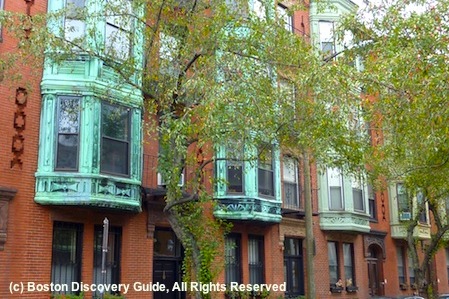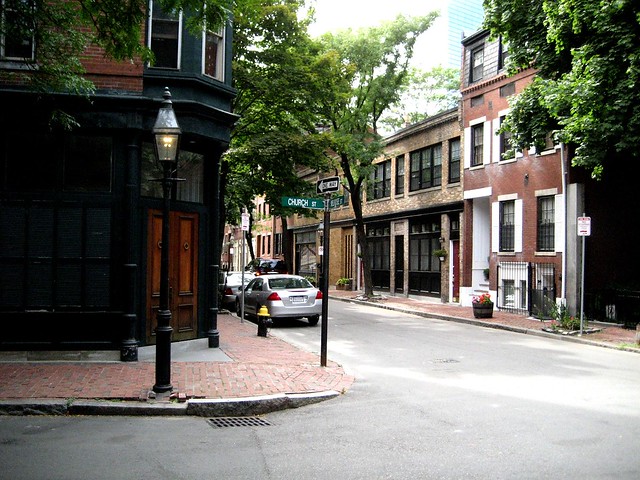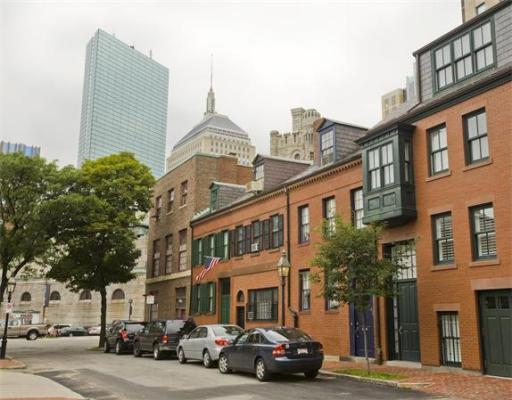Bay Village (Boston)
Suffolk
Bay Village is the second-smallest and probably the least known area ( Neighborhood) in downtown Boston, Massachusetts in the United States. 2010 lived there 1,312 inhabitants in 837 households.
The district has traditionally been the residence of the middle class and the lower middle class, but recently has become relatively expensive. The Bay Village Neighborhood Association ( BVNA ) was very heavily involved in the district and is responsible for matters such as road transport, waste disposal and the removal of graffiti and dog mess. She also organized in the spring and autumn special clean-up days, runs a book club and organized annually the Bay Village Annual Neighborhood Block Party from.
- 3.1 parks
- 4.1 traffic
Geography
Expansion of the urban area
In the south of the district is surrounded by the Massachusetts Turnpike, on which also runs the laid in the 1830s rail of Boston and Albany Railroad. On the surface of the Marginal Road and the Cortes Street run parallel to the Turnpike. To the southwest lies on the other side of the Turnpike 's South End, in the southeast the southern end of Chinatown. To the west of Berkeley Street and north of Columbus Street is the Back Bay area. North of Stuart Street is the Park Square, and to the east of Charles Street is the Washington Street Theatre District. These limits are determined by the Bay Village Neighborhood Association.
History
The western part of Bay Village was originally part of the bay to the west of Boston Neck was and was piled up in the 19th century to the Back Bay area. In the 1820s the then known as South Bay area was filled by Ephraim Marsh Francis Cabot Lowell, together with before the land reclamation for the Back Bay and South End. Throughout its history, Bay Village was known at various times as Church Street District, South Cove and Kerry Village.
From an architectural point of view, many of the houses look in Bay Village like smaller versions of the spacious houses in Beacon Hill. This is because that the craftsmen who built the houses in Beacon Hill, Bay Village built their own homes and those designed in the same style. To stand in the Fayette Street, named after the Marquis de Lafayette today, many homes in the Federal style. Larger, five-storey building in the style of Greek Revival standing in the Melrose Street. After the area was west of Arlington Street filled up, the city developers built there along the streets Cortes and Isabella luxury " hotels " in the Victorian style.
In the second half of the 19th century, some streets of the neighborhood were raised by 4 to 6 m in order to connect it with the adjoining, by further land fills newly created areas of the South End and Back Bay can. Even today, these features can be seen from the position of the basement windows of some houses in the Fayette Street. Some gardens were, however, never adjusted to the new level and are still on their original height.
Bay Village was the scene of a devastating fire which broke out in November 1942 at the Cocoanut Grove nightclub and 492 people lost their lives. This led to the introduction and enforcement of restrictive measures for fire protection throughout the United States to prevent further accidents of this magnitude. On the 50th anniversary of the disaster, a memorial plaque in the sidewalk near the former club was taken in by the Bay Village Neighborhood Association, the building now houses the Radisson Hotel.
Culture and sights
Parks
In Bay Village, there are some small green areas such as the Eliot Norton Park. The Boston Public Garden and Boston Common are just two blocks from the north end of the district.
Economy and infrastructure
The close network of one-way streets and the unusual arrangement of the road guides mean that it is relatively quiet within Bay Village and due to the low volume of traffic, many pedestrians are traveling. Many sidewalks are paved with bricks and are illuminated at night by gas lamps. The external appearance of the houses is especially protected by designation as a Historic District by the Bay Village Architectural Commission.
Traffic
In the immediate vicinity of the district boundaries there are several stops on the MBTA ( Arlington, Back Bay, Boylston and Tufts Medical Center ), and also some bus routes run through Bay Village. At the stations, Back Bay and Boston South Station stop Amtrak and commuter trains and intercity buses.
Parking on the streets are very scarce and reserved for the most part for holders of residents parking permits. Motorists are therefore largely dependent on paid parking garages and parking lots. Access roads to I- 90 and I-93 are just a minute's drive away.







